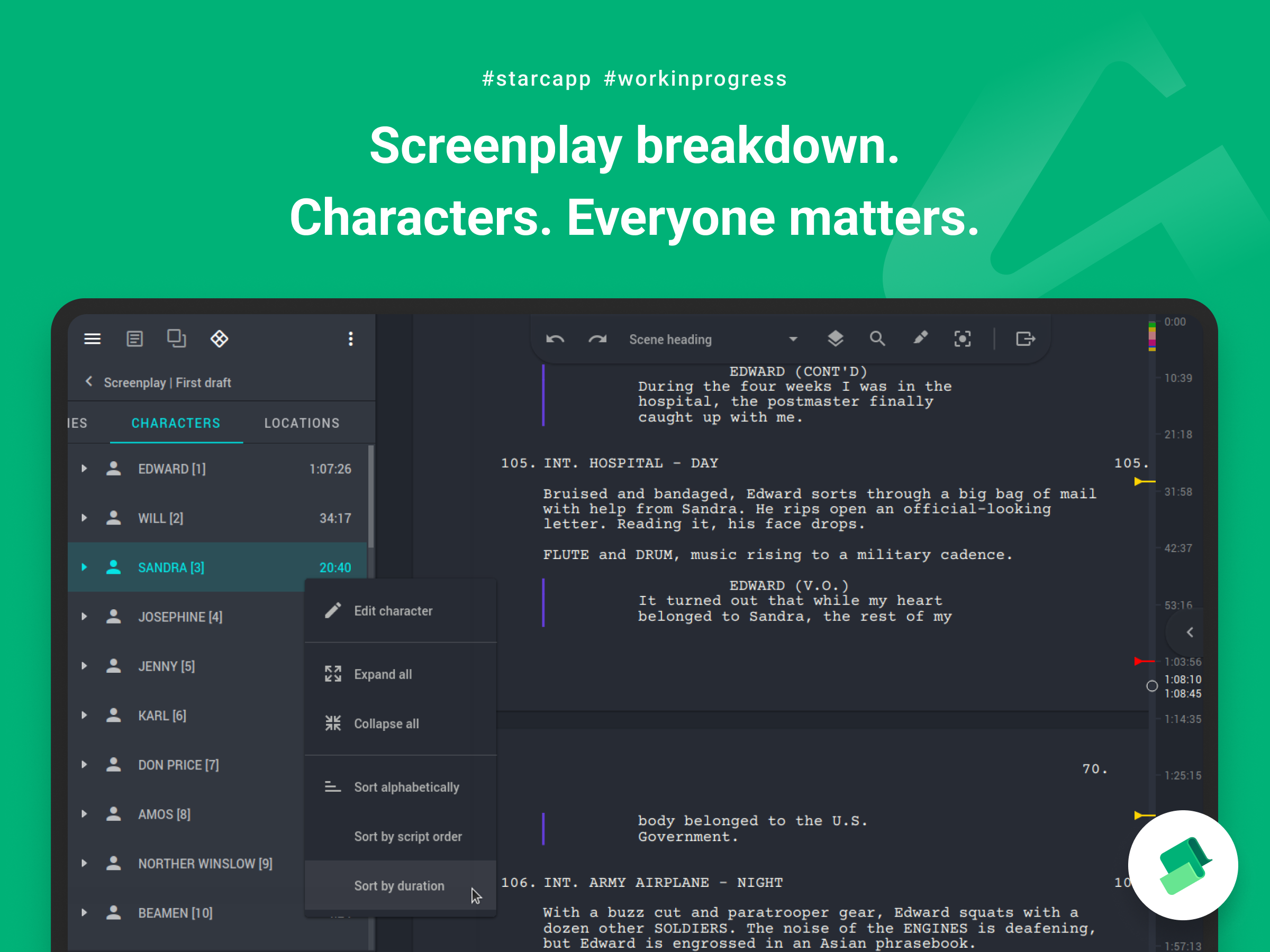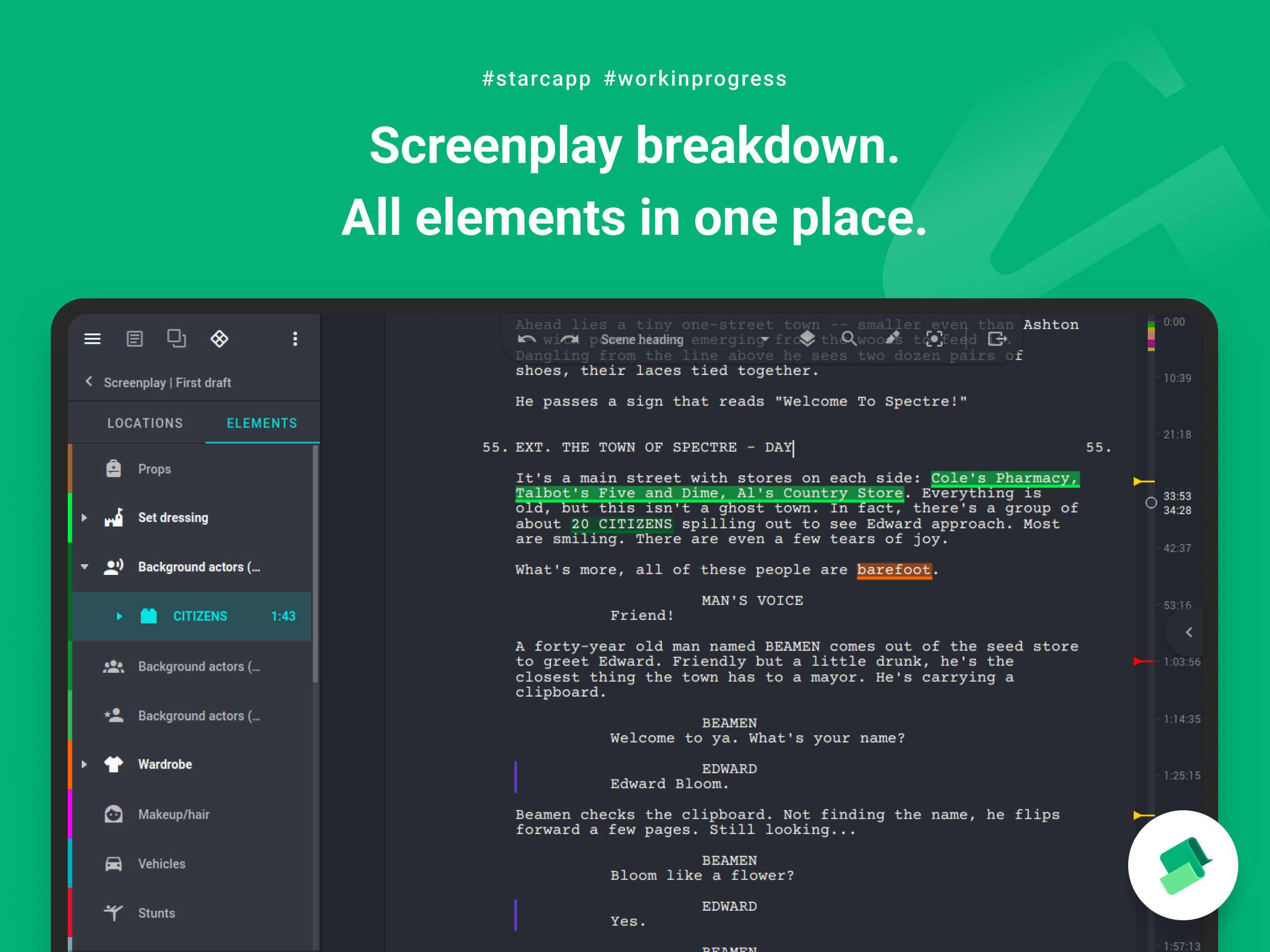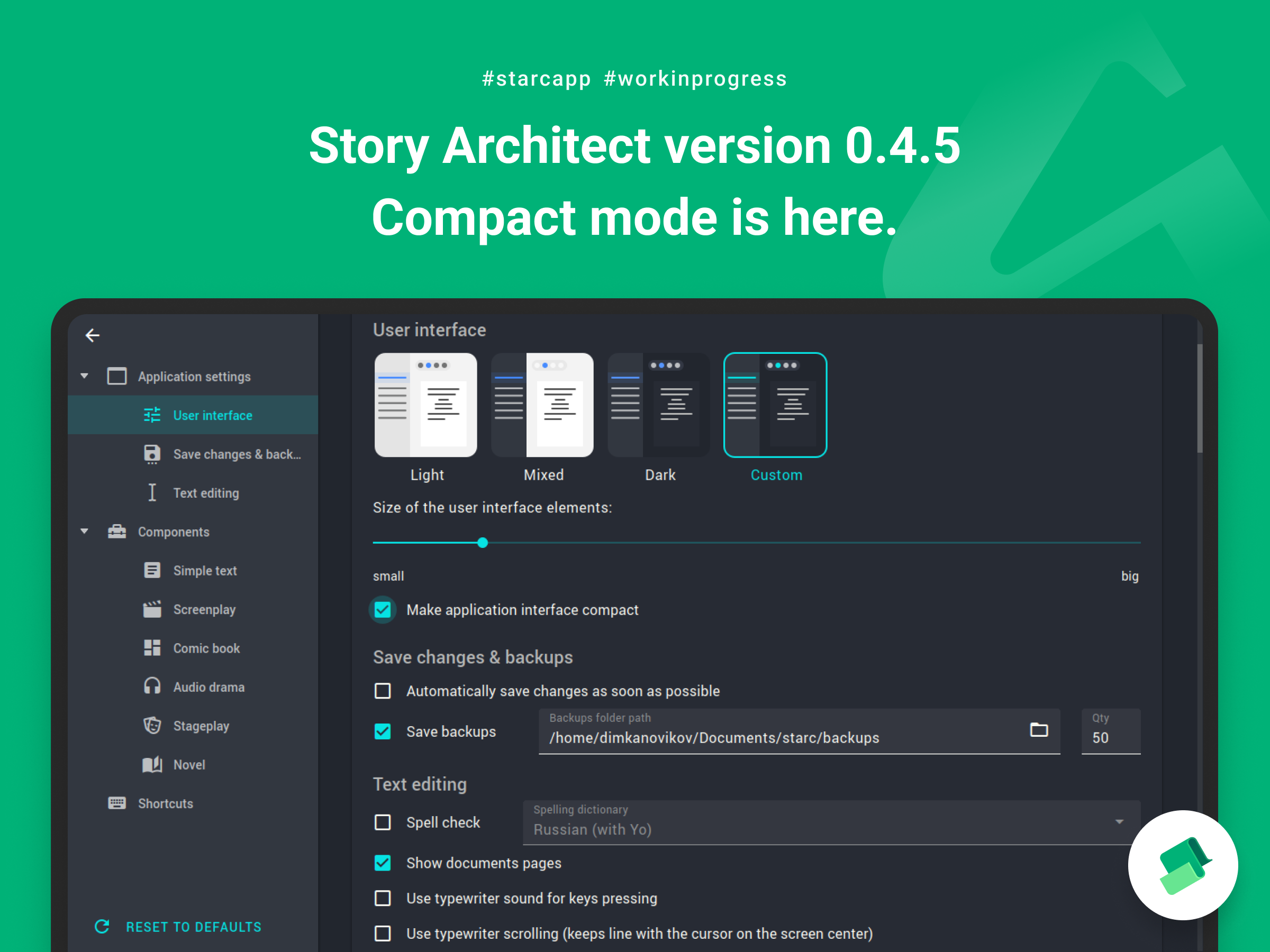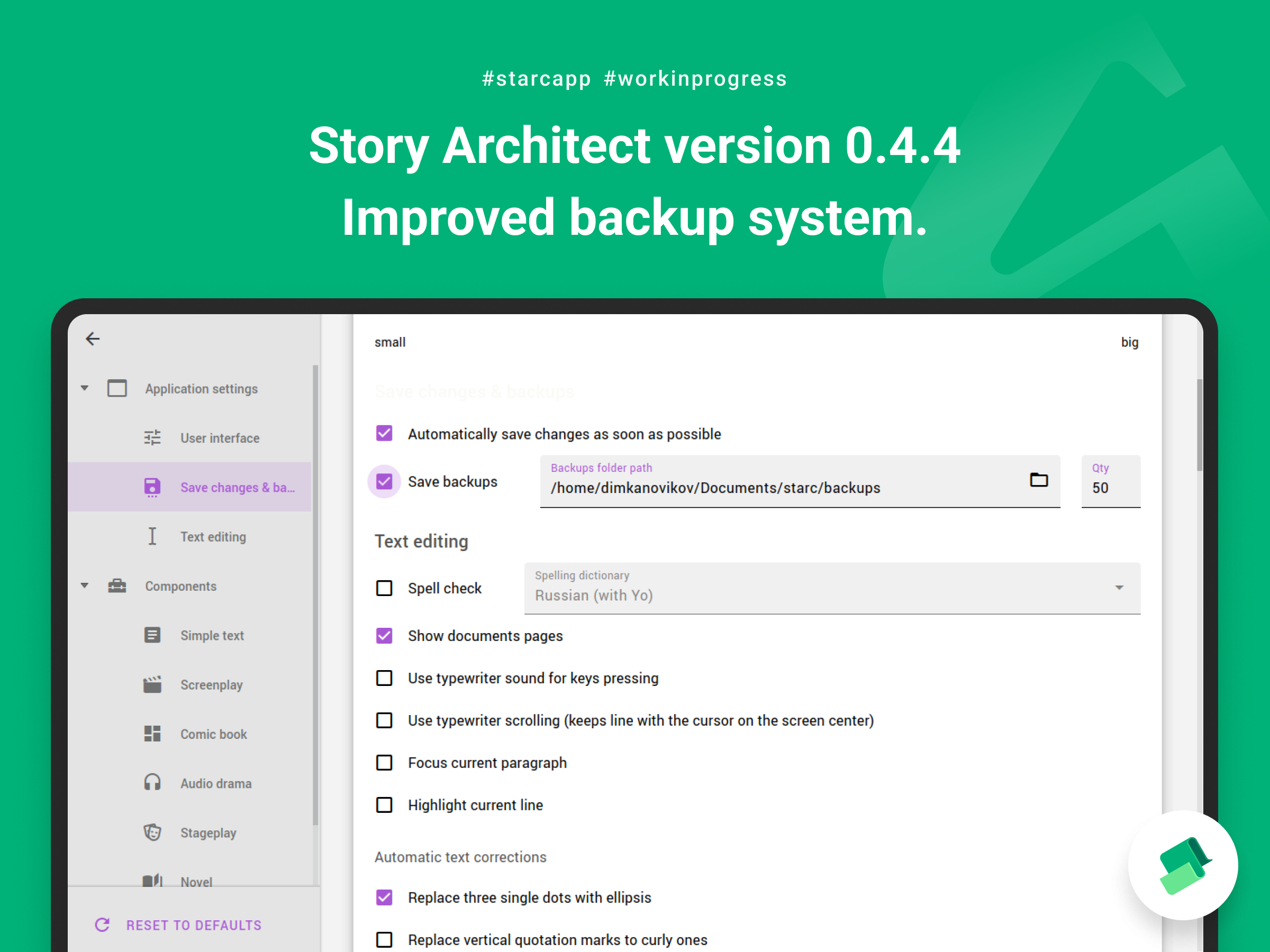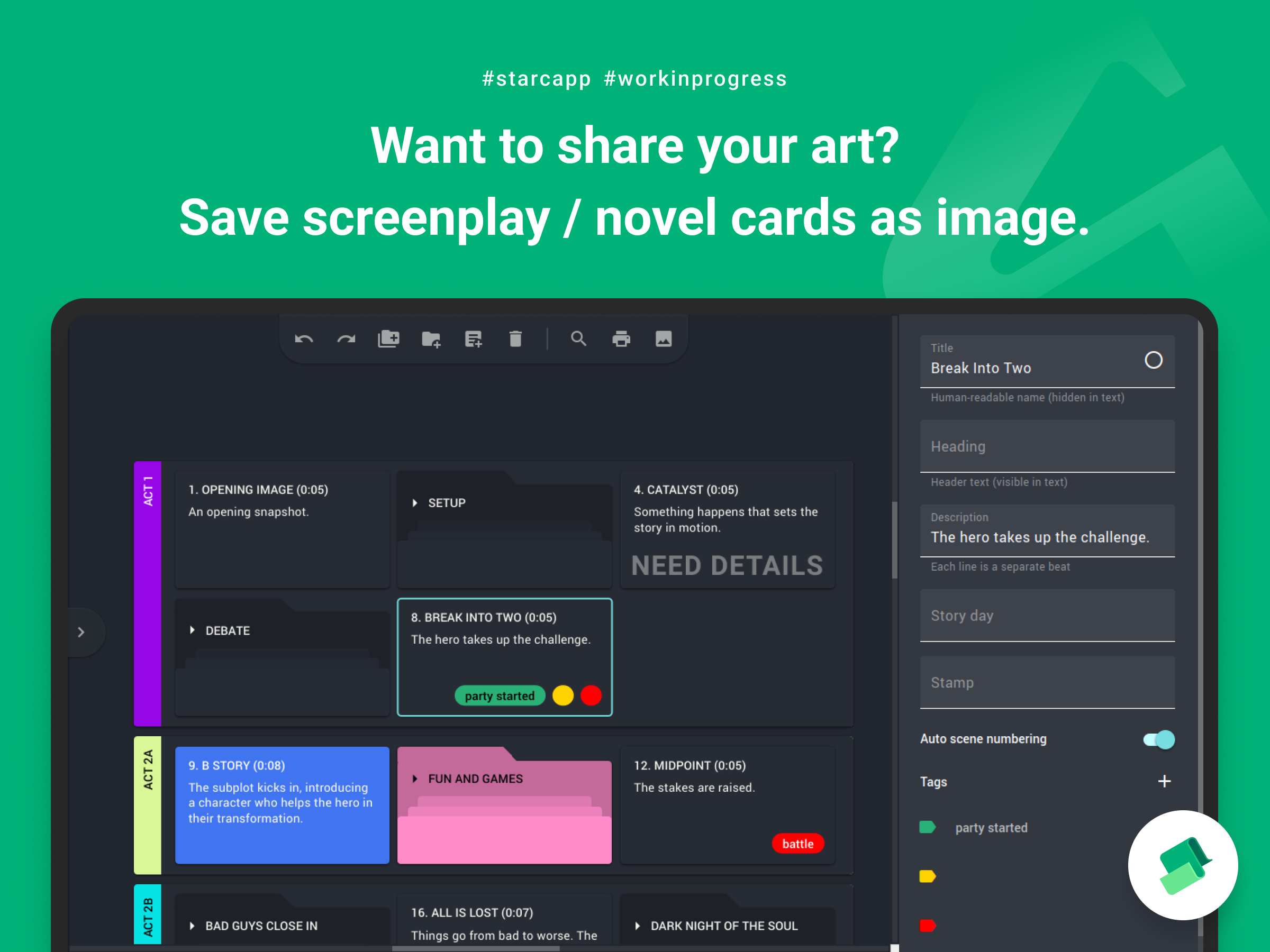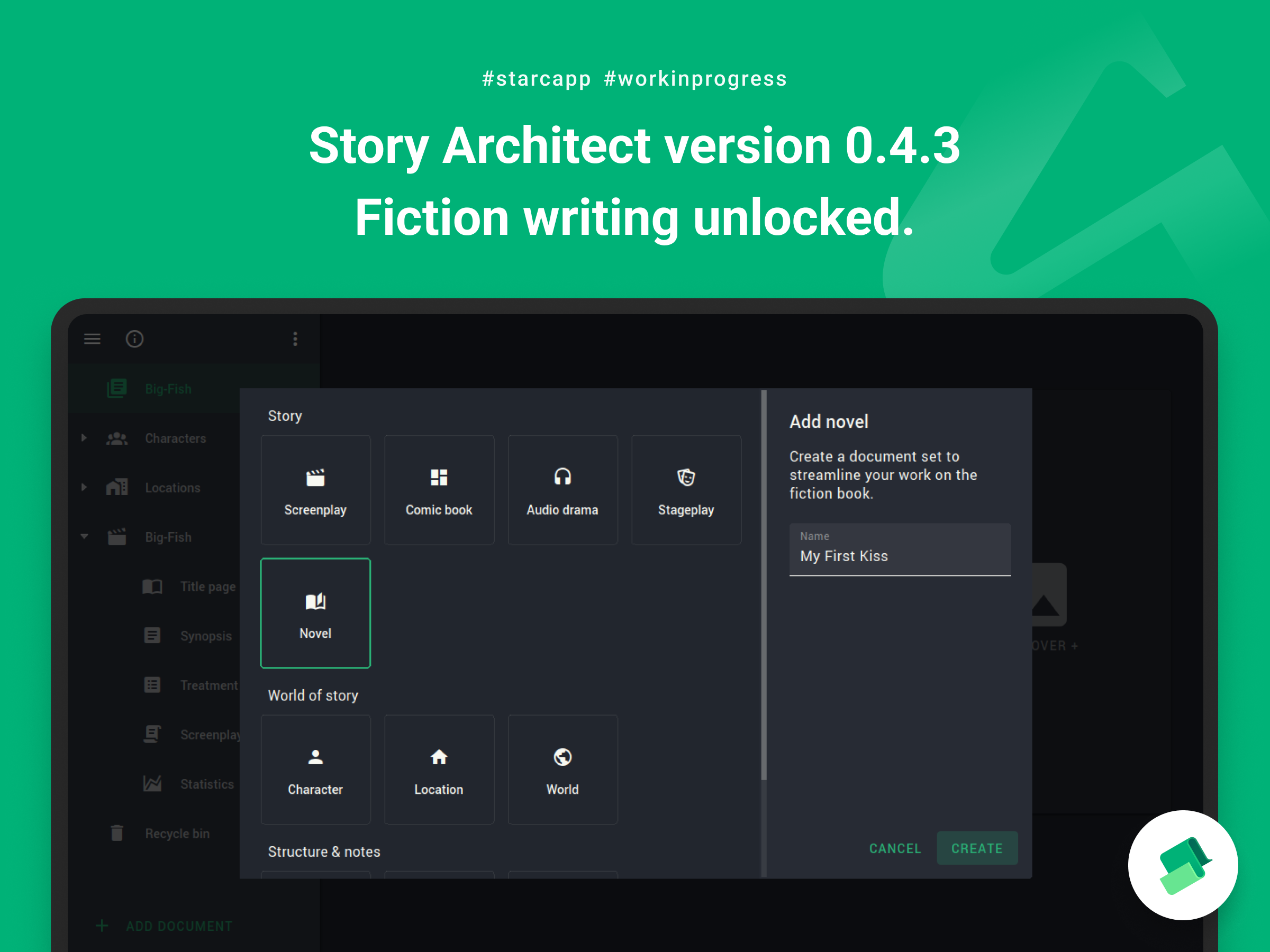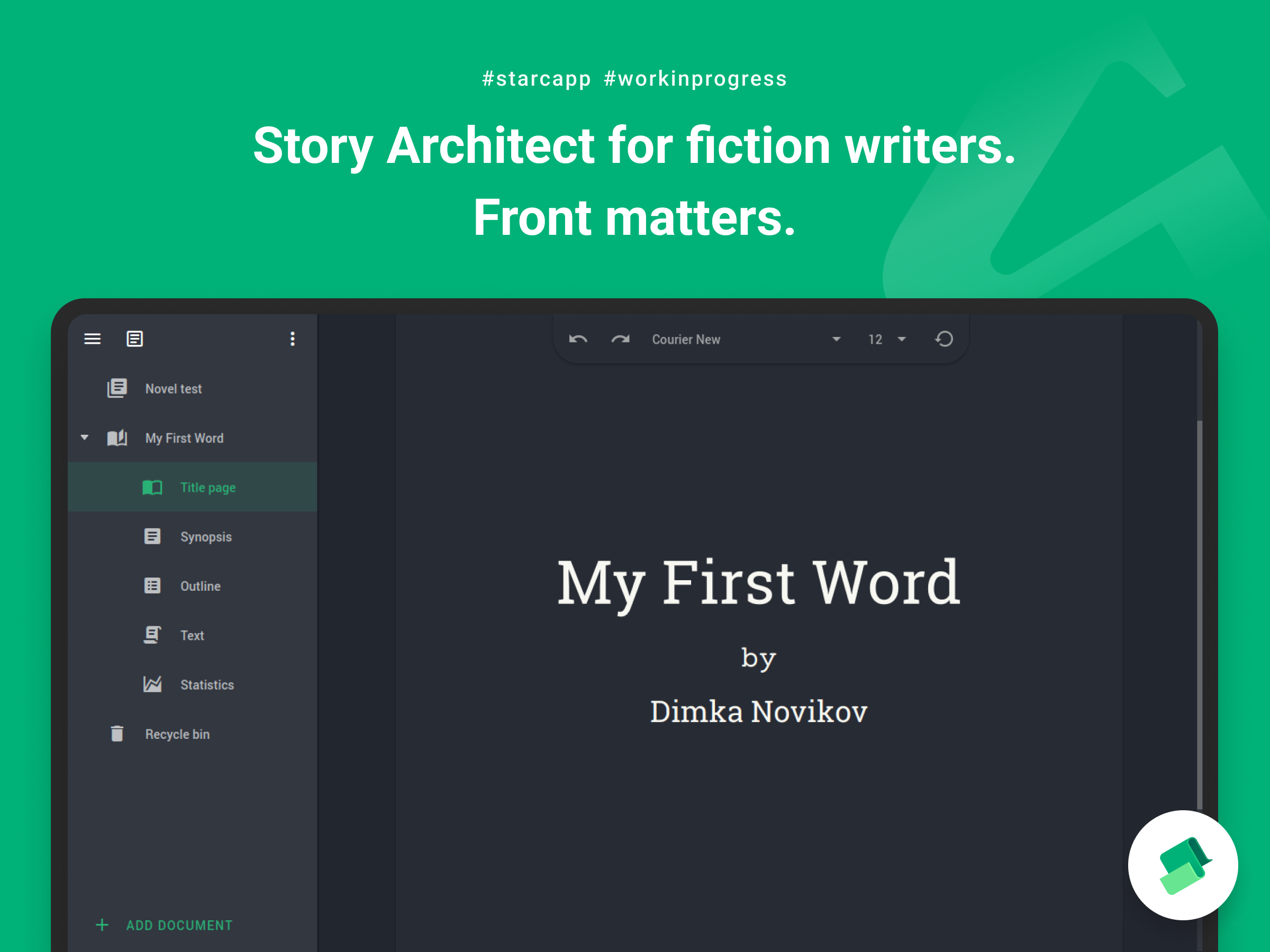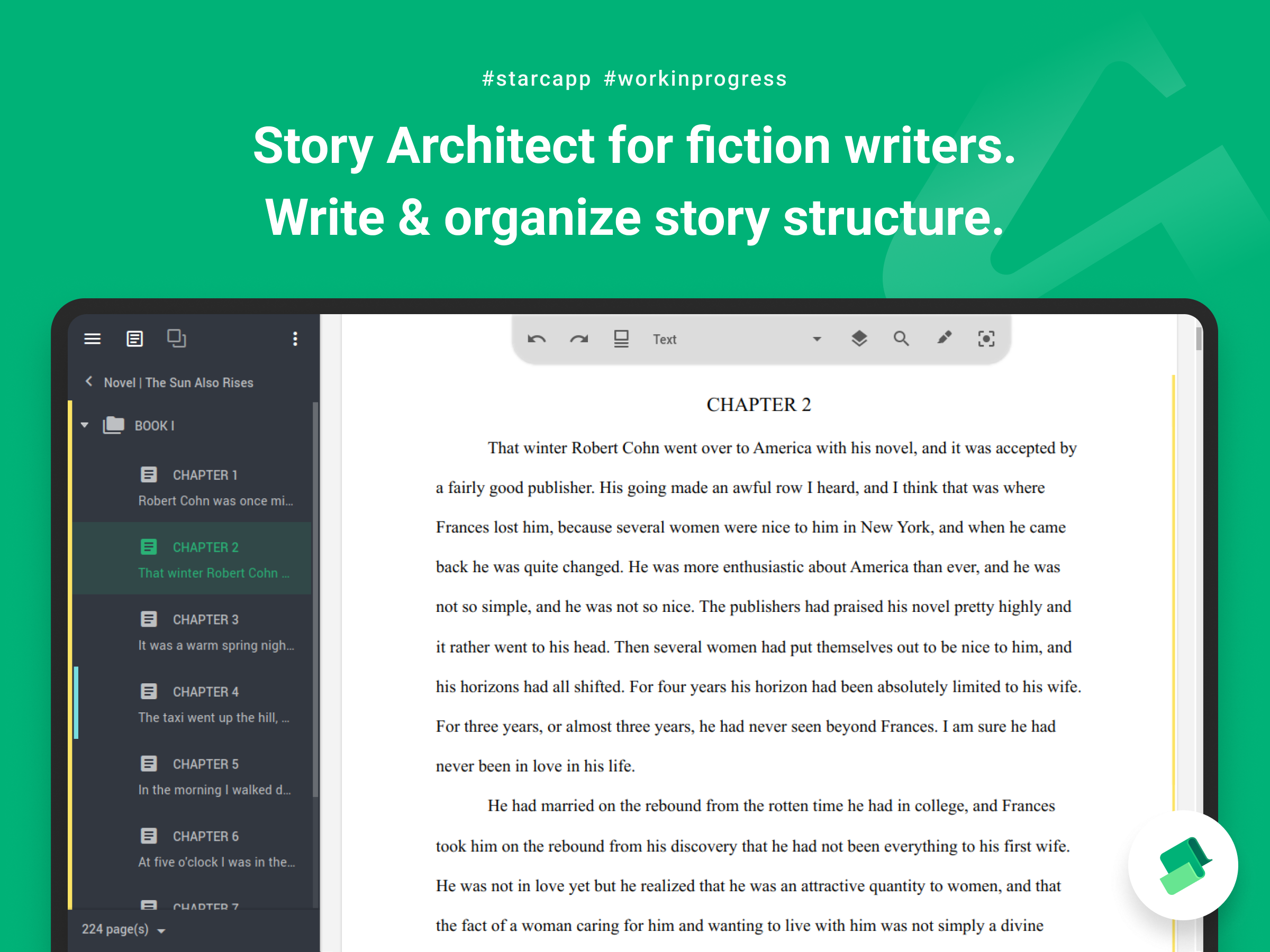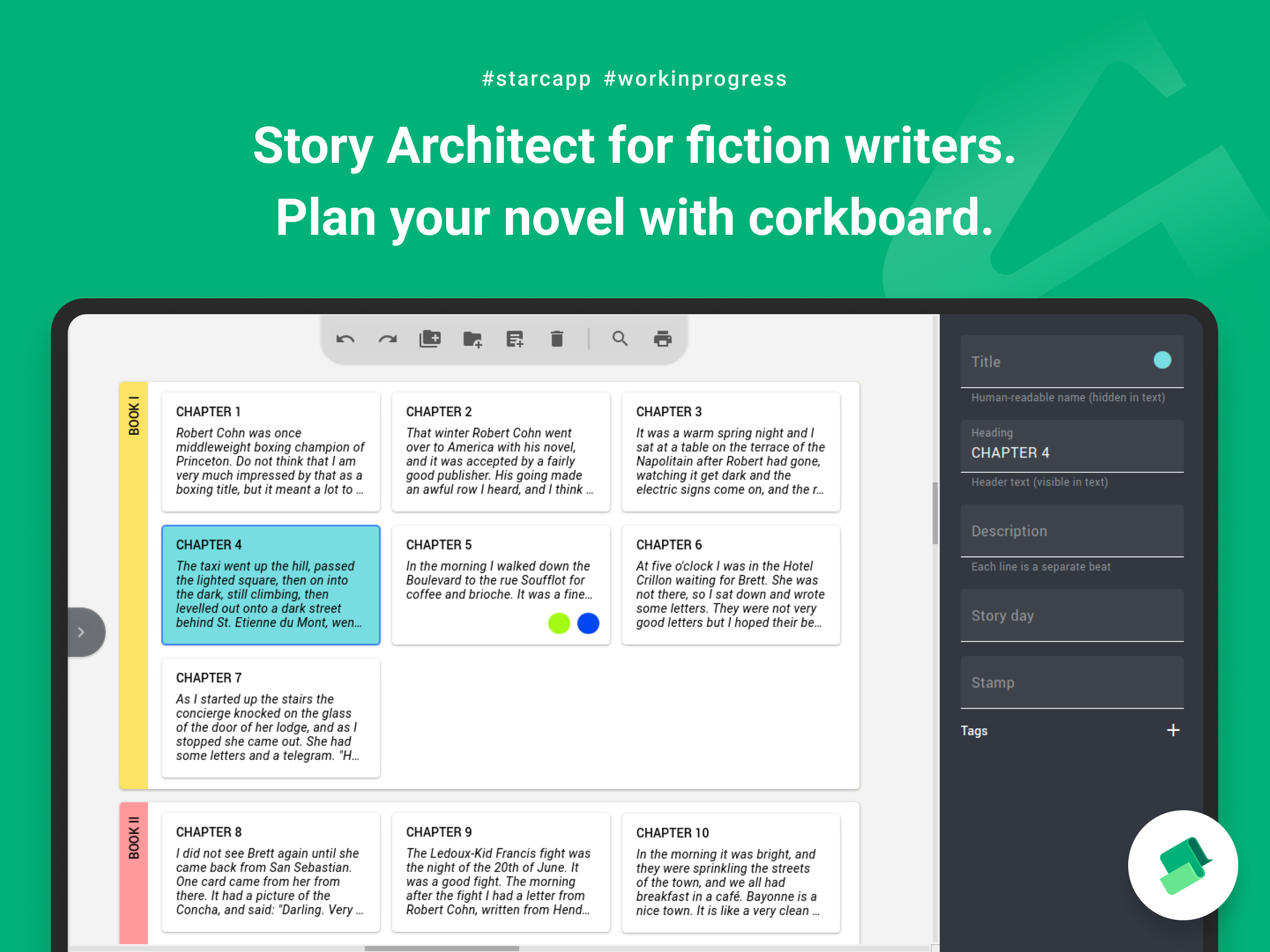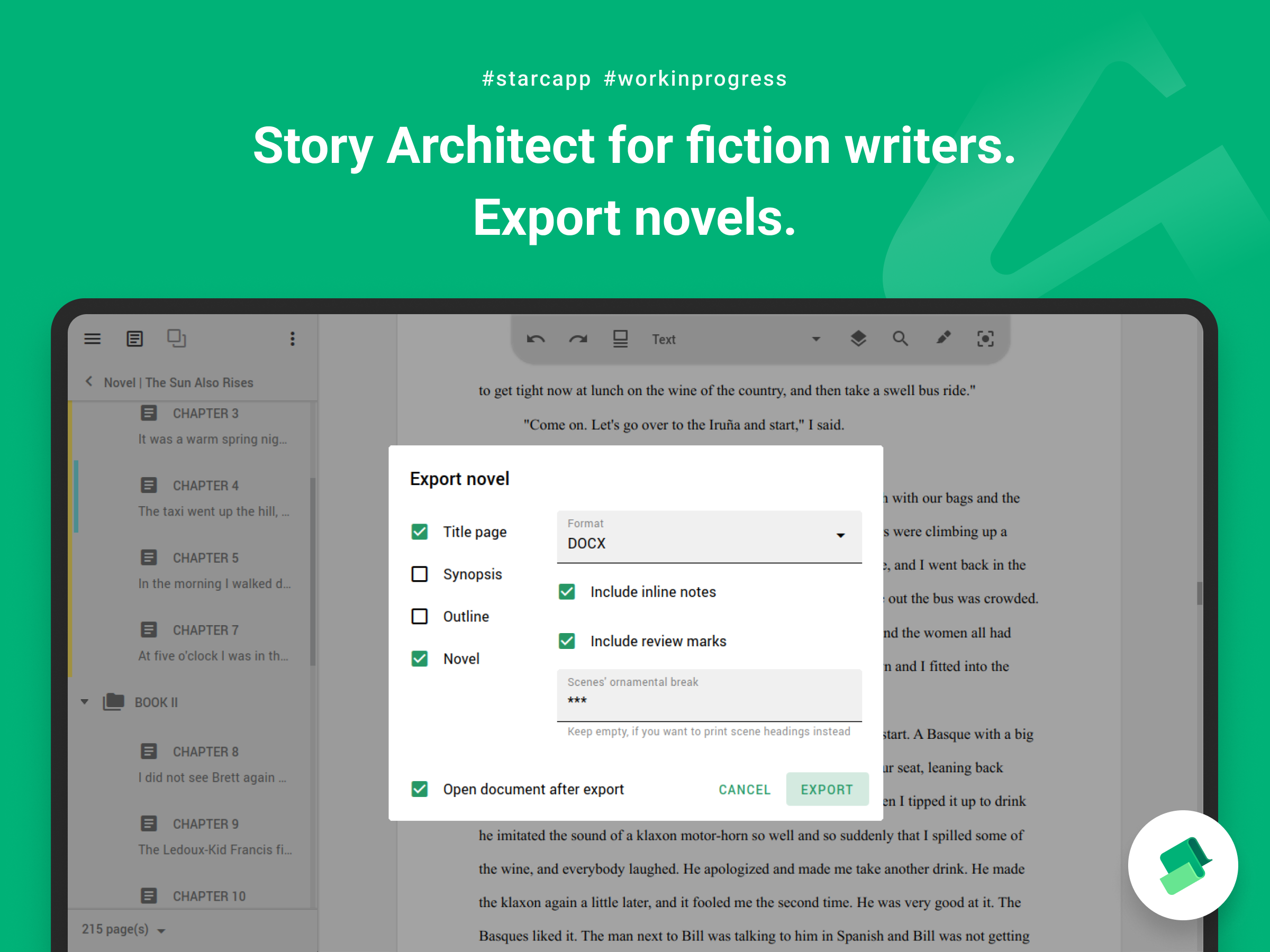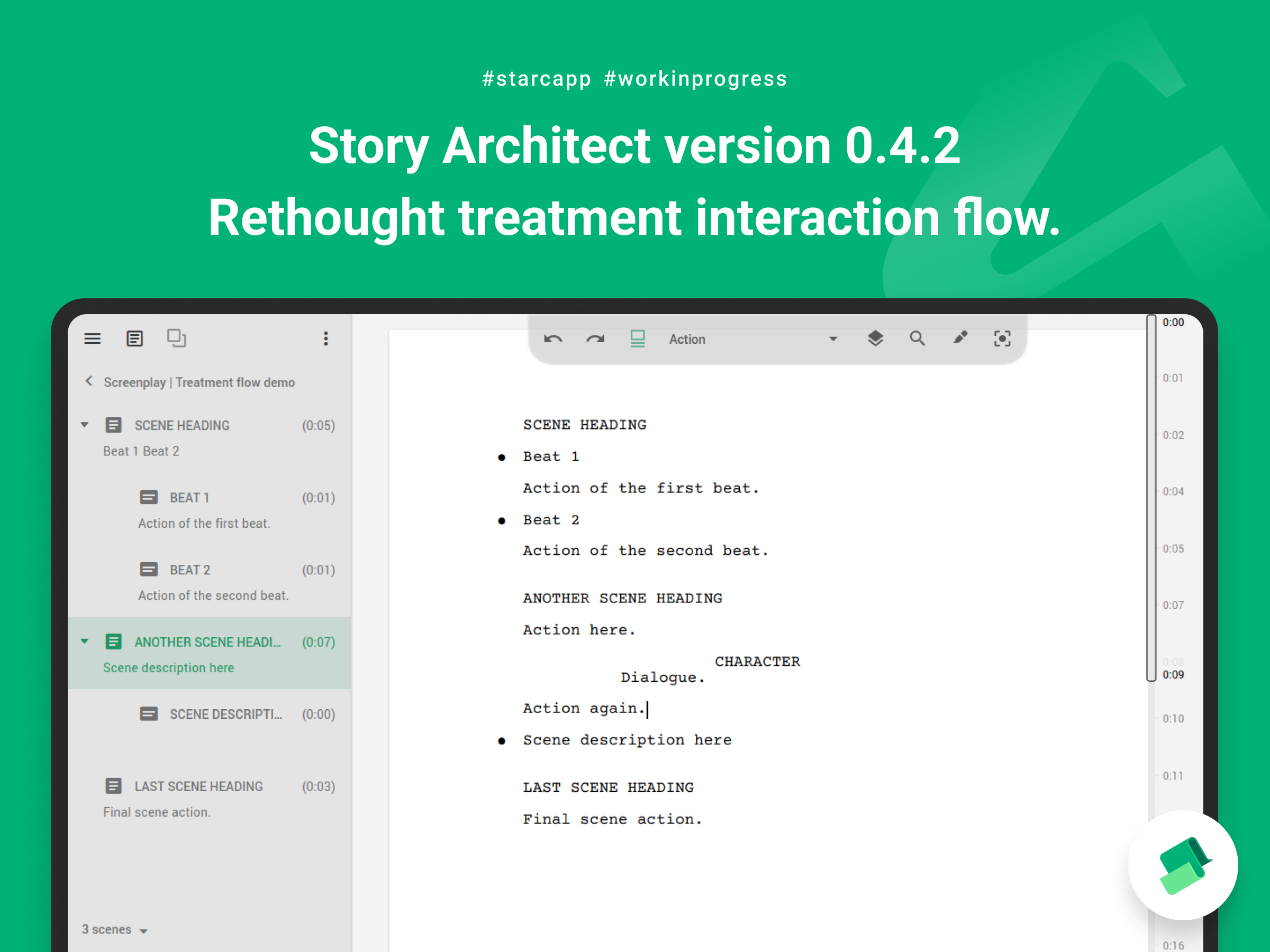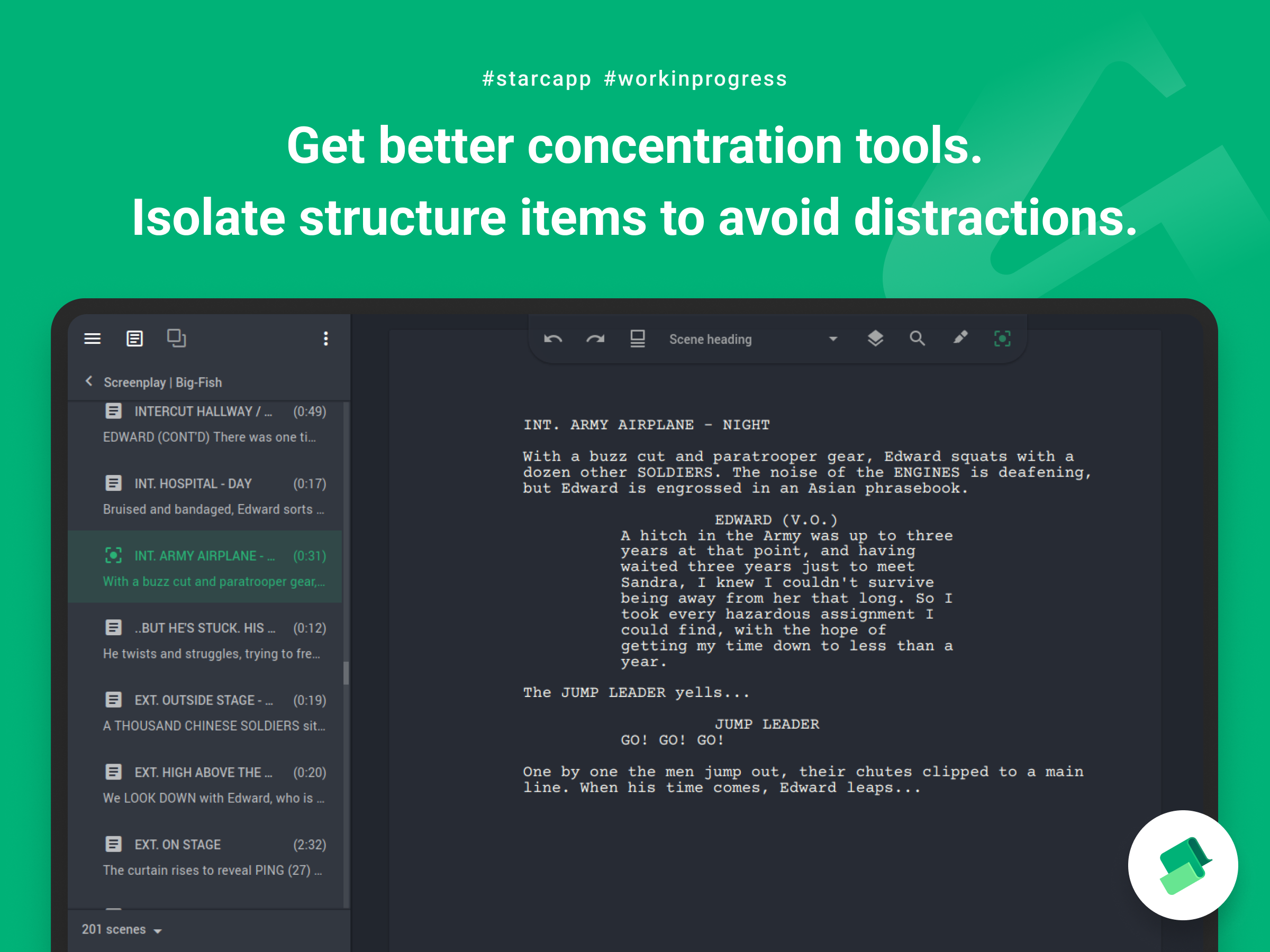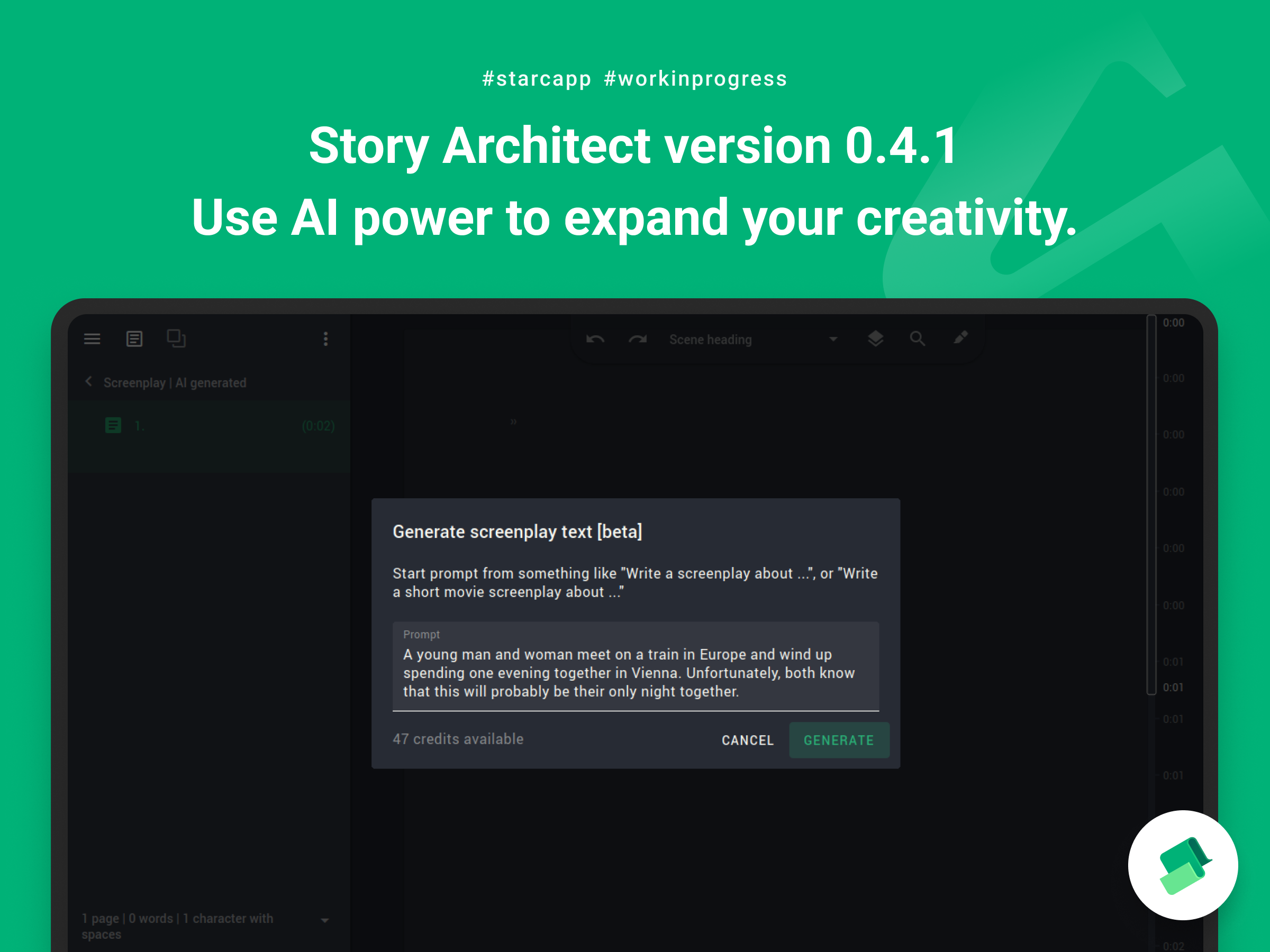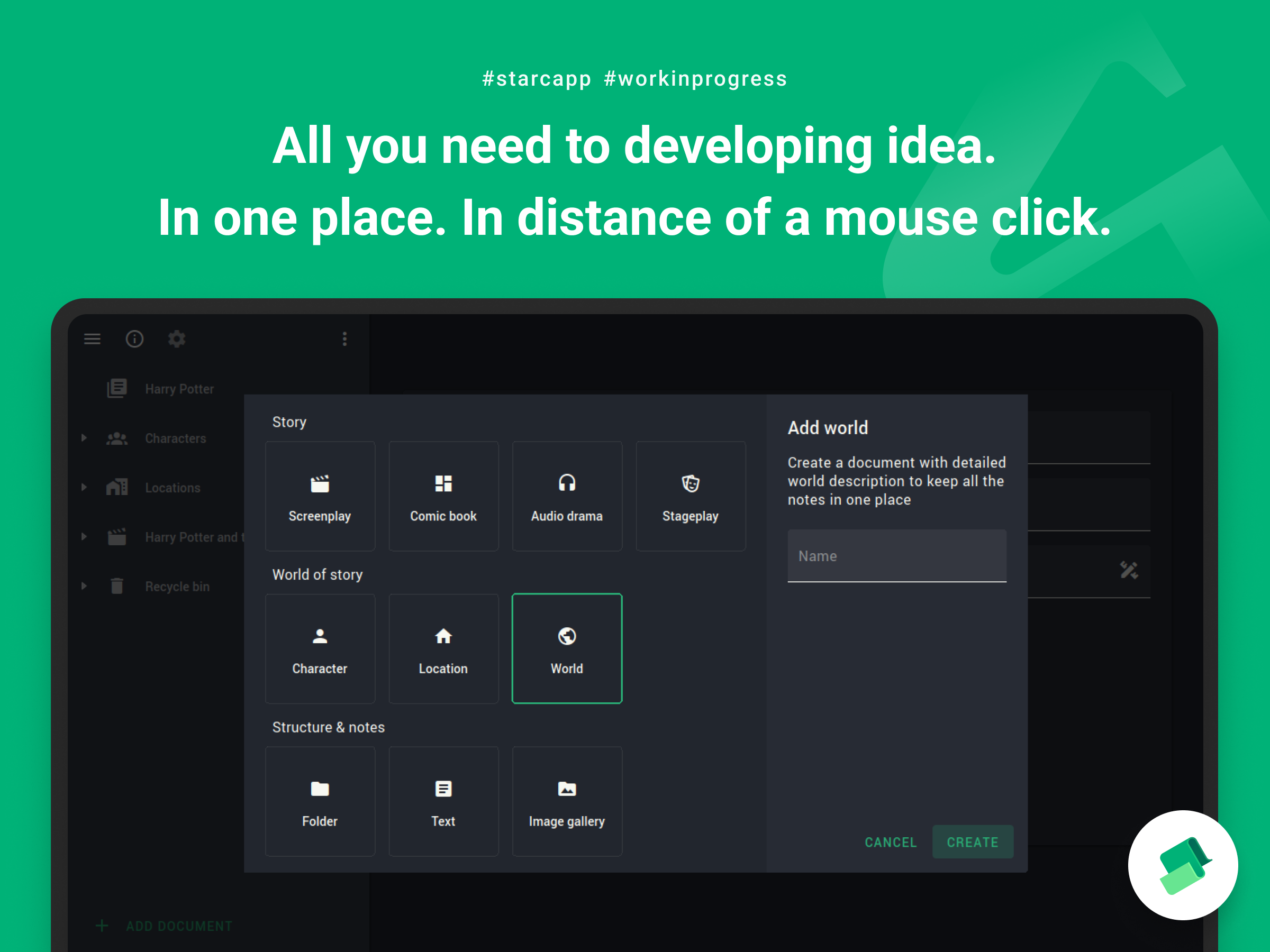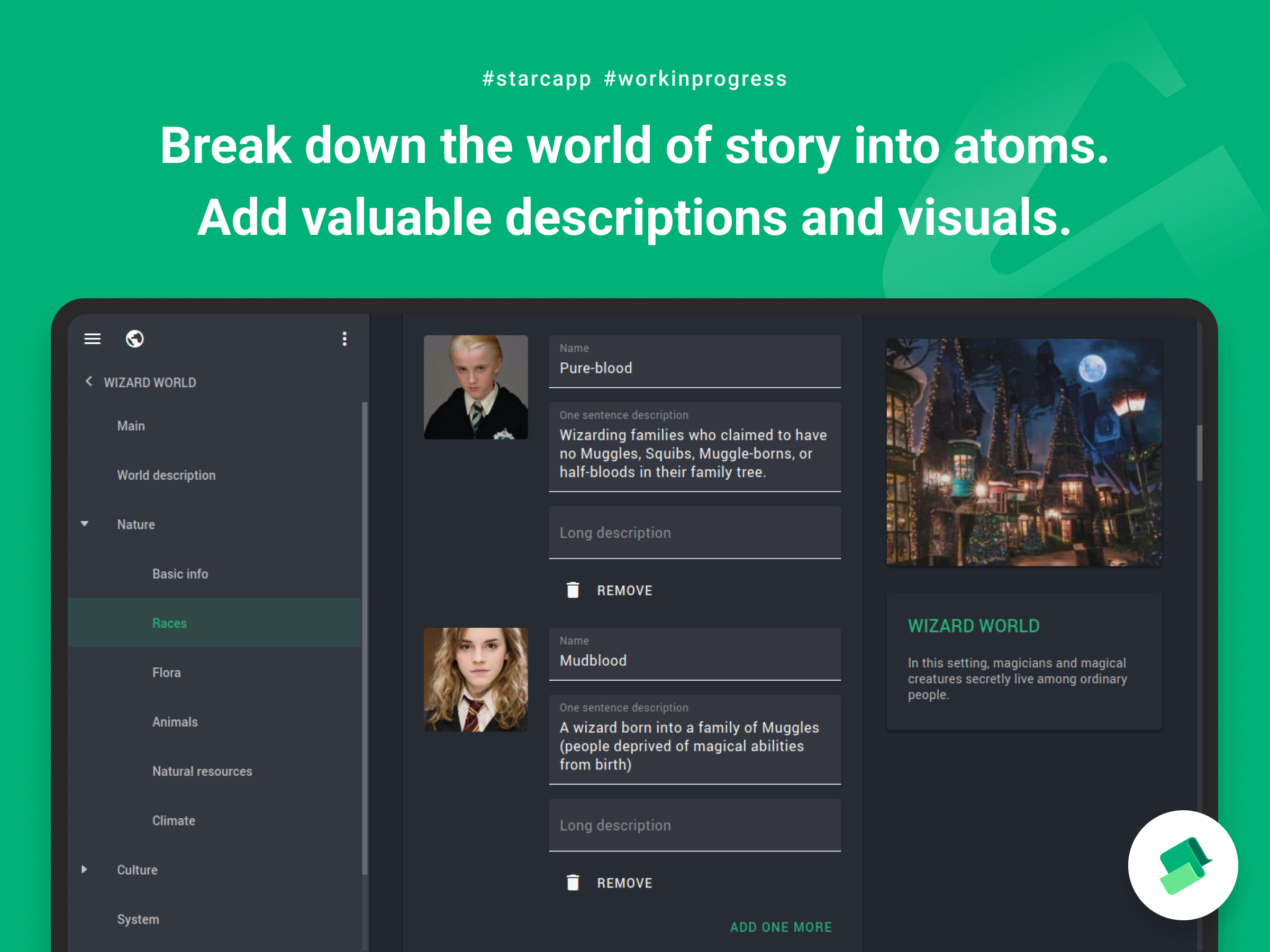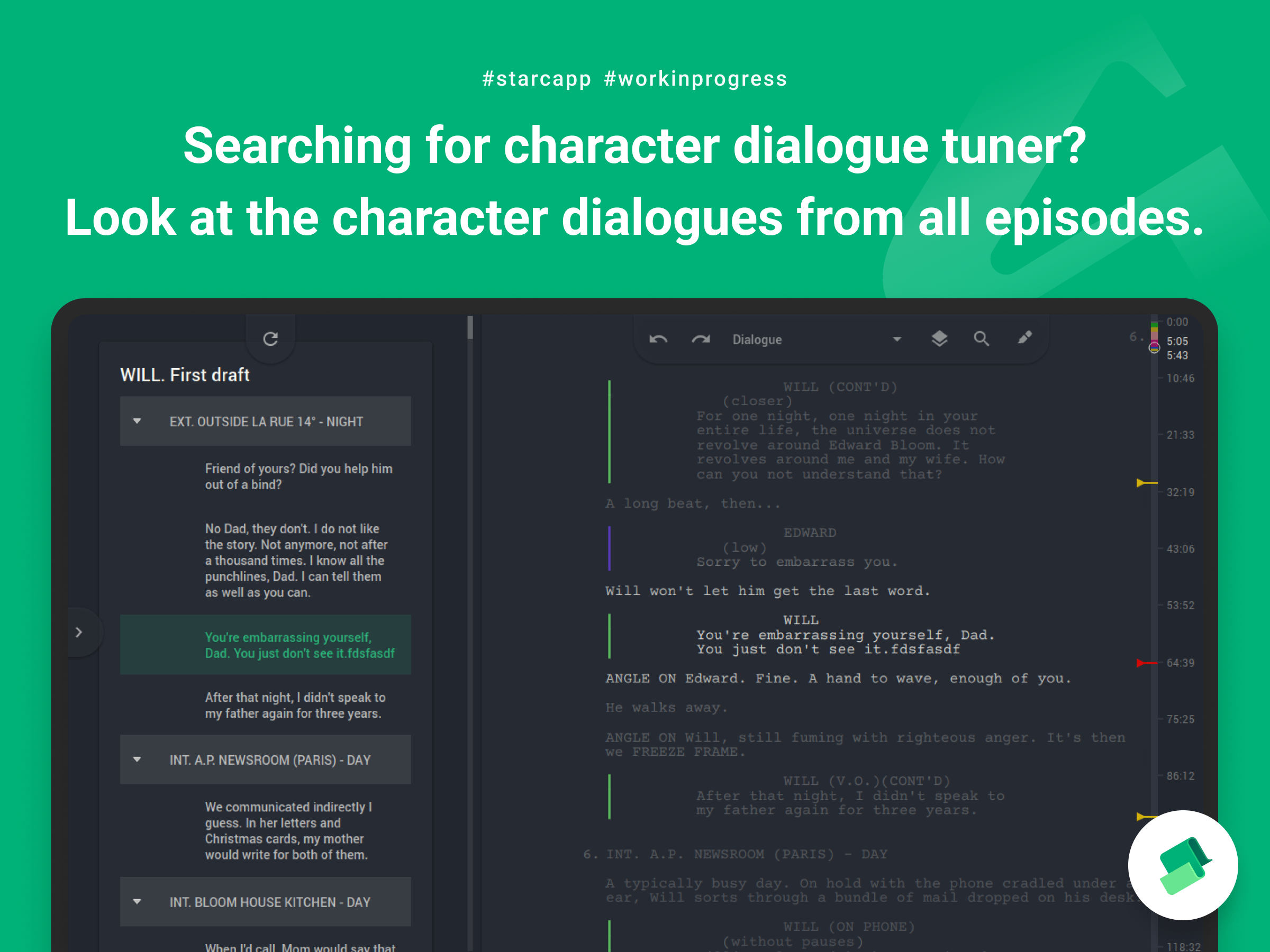Releases: story-apps/starc
Story Architect 0.5.0a
Hey folks!
It's a small hotfix-release which fix degradation brings by the version 0.5.0 with Courier fonts rendering.
Happy writing! :)
Story Architect 0.5.0
Hi, friends!
Today we're finally ready to take our first step towards preproduction tools! Story Architect 0.5.0 adds the ability to create a script breakdown!
Script breakdown module
The breakdown module gives you access to all the classic tools for filling a script with elements (props, vehicles, background actors, makeup, costumes, animals, etc.).
Breakdown module is available for users of the TEAM version. It can be activated from the modules panel, which is located in the upper left corner, to the right of the main application menu display button.
Navigation
The best way to get started with the breakdown module is with the navigation tools it provides. The Navigator gives you access to four types of navigation:
Scenes
The first is the standard navigation through the list of scenes.
Here you can rearrange scenes and move between them, using the list as a sort of table of contents for the script.
Characters
Here we have a list of characters that are directly involved in the script. For each character, you can see a list of scenes and their Board ID.
When the cursor hits a particular scene of the script, the characters involved in the current scene are additionally highlighted in the list.
Using the context menu, the list of characters can be easily sorted alphabetically, or by occupation in scenes. It also has the option to edit the character, so you can immediately add brief information to the character, or rename them.
In addition to sorting characters using the context menu, you can rearrange them in this list manually to organize the list in a way that is convenient for you.
Locations
Location navigation is very similar to character navigation with one big exception - it is able to build the structure of locations with sub-locations. The program automatically parses the names of locations and groups them in such a way as to show you the most compact structure of the list of locations while providing it in a tree-like form (from the general to the particular).
You can also reorder locations using the context menu, or by dragging and dropping them, edit and navigate to specific scenes of each location.
Elements
Finally, navigating through the list of script elements.
Here you have access to a list of standard elements categories. You can edit it by changing the names, dragging and dropping them in the order you want, as well as by deleting and adding new ones if you don't have enough of the standard ones.
When specific elements are added to the script, they will all appear in their categories and can also be edited.
Breakdown
Once you've got acquainted with the navigation, it's time to take a look at the central workspace and explore in detail how you can fill a scene with elements.
To add an element to a scene, you can highlight the text the element will refer to and click the Add button in the toolbar that appears to the right of the highlighted text. The sidebar will open the add element page, where you can customize the quantity, description, and even specify the details that apply only to a particular scene.
If there is no text in the scene for which you want to add an element, or if you just don't like too colorful script, you can click the Add element button, which is in the upper right corner of the right sidebar.
The added element will then appear in the list of all the resources and you can change it if necessary, or remove it from the scene using the context menu in the elements list.
And you'll find more options for adding elements to the scene when you click on the three dot button in the upper right corner of the elements list panel. There you will find options for adding a list of elements of a specific category, as well as options for copying a list of all elements from another scene to the current one and vice versa.
Exporting
After the script has been filled with elements, Story Architect will give you the option to export all the information about it as an excel file (.xlsx).
To save it, click the appropriate button in the central toolbar, and then specify the file where you want to save the script breakdown table.
Other improvements
Today's release includes other improvements to the program, namely:
- the ability to mark an editor's note as done, or delete it, is added directly into the review mode's auxiliary toolbar;
- the color palette of standard themes of the application is improved in terms of error display;
- the default poster size for the project is corrected, now it does not differ from the user-generaget posters and the start page looks more neat;
- display of the list of co-authors of the previous project when you open another project is fixed;
- an issue with saving the order of characters and locations when synchronizing a cloud project is fixed;
- an issue with updating and rewriting the project structure when you reconnect to the cloud server is fixed;
- an issue with the rendering of co-authors' avatars is fixed;
- an issue with co-authors cursors jumping when adding text is fixed, now they are displayed accurately in the places where the co-author's cursor is located;
- the problem with renaming complex locations, when the script has locations of the type "HOUSE" and "HOUSE - KITCHEN" is fixed - renaming the main location now leads to renaming of the sublocations;
- a crash when working simultaneously in several text editors on the same script is fixed;
- crashes while dragging and dropping items in the treatment are fixed;
- crashes when adding new lines in some cases when working with comics are fixed;
- an issue with updating line numbers at the end of large comic book scripts is fixed;
- an issue with interline indentation when dragging the first scene in a structure is fixed;
- a crash when launching on some versions of 32-bit Windows is fixed;
- an issue with the display of fonts in Windows is fixed (first of all, this applies to fonts which characters have different width, such as Arial).
That's it, guys :)
I hope you like everything that's happening here! And even if you don't, tell us about it! Send us your wishes and impressions - let's improve and develop our common cause together!
Story Architect 0.4.5
Hello, story architects! :)
Today we publish another stabilization update of Story Architect 0.4.5 with compact mode on board!
Compact Mode
The compact mode was one of the most often requested features by our users since the very first version of STARC.
Modern visual design systems always emphasize the necessity of "free space" in the workspace, the elimination of redundant elements and visual identification through the grouping and separation of elements. And this works fine when there is enough workspace, but when we are dealing with small screens, it turns into a very big problem with constant scrolling up and down...
And to solve this problem, Material Design (the design system on which Story Architect's interface is based) offers an interface flattening feature, which aim is to reduce the vertical indentation between interface elements.
Of course, we didn't just implement it in the standard version, but subjected it to creative rethinking within the objectives of our application and now offer you to try it out!
You can turn on the compact mode in the "Appearance" section of the application settings.
Try it and be sure to share your impressions with us.
Other improvements
The compact mode required a lot of attention and time, as we had to thoroughly work through each screen of the application and test it. Nevertheless, the release of 0.4.5 has gained a few more improvements aimed at improving the stability and usability of the application. This includes the following things:
- location map icon is updated;
- the number of items in dropdown lists is increased;
- scene parameter fields in the script card/text modes are adjusted;
- quick format bar got the ability to show/hide hotkeys for all text modules;
- identifying of the character line numbers is improved;
- line numbers are added to the character line report;
- synopsis styling for plays is improved;
- a crash when transferring structure elements in comics, podcasts, and plays is fixed;
- an issue with creating worlds from a universe map is fixed;
- a crash when synchronizing offline changes in cloud projects is fixed;
- an issue with synchronizing script guides is fixed;
- an issue with creating redundant documents in cloud projects when syncing for the first time in some cases is fixed.
What's next?
Moving on to version 0.5, which will expand Story Architect's universe of features and bring the ability to work with script breakdown, an improved intelligent assistant and the first showrunner tools.
It's going to be very exciting! Subscribe to our social networks, so you don't miss any news! ;)
Story Architect 0.4.4
Hello, everyone!
It's time to publish the update of Story Architect 0.4.4. It includes a revamped project backup system, as well as many improvements to stabilize the application.
Backups
We understand how important backups are and that's why we put a lot of emphasis on this aspect of the app. That's why version 0.4.4 has evolved the backup system.
You can now set the number of backups that the application will keep. With each backup, a new copy of the current project is created, and old copies that exceed the maximum number of backups for one project will be deleted in order not to clog up the hard drive.
Such backup system is the simpliest, the most clear and effective, and will allow you to forget about the lost changes which earlier, though occasionally, took place.
Saving charts and cards to an image
We also added the ability to save characters, locations, worlds maps, and even cards to an image file.
Now you can save and print all these schemes to hang them in your workplace like a real detective, or to share theis beauty with friends :) By the way, if you do, be sure to tag us on social media and we'll share your creativity with everyone!
Other improvements
And of course, here are some stabilization improvements to the new release:
- an algorithm for determining locations for auto-complete is improved;
- an ability to turn off line numbers in the comic module is added;
- search for the characters and locations in the current script is improved;
- application behavior when trying to create a project in a folder where the user cannot write data is improved;
- translation of the application into Telugu is added;
- an issue with updating the line height of formats that have a custom line height set is fixed;
- an issue with word and character count in novel statistics is fixed;
- an issue with pasting scene titles from the clipboard when scene numbers are locked is fixed;
- several problems that caused crashes when viewing statistics are fixed;
- a crash in the comic book module when cancelling the last action after pasting the text of the character's lines from the clipboard is fixed;
- an issue with a single character of a character's name being overwritten in a comic when pasting the text from the clipboard is fixed;
- an issue with exporting specific scenes is fixed;
- an issue with updating timing when changing a script template is fixed;
- an issue with updating translations in some parts of the application when changing the interface language is fixed;
- an issue with refreshing the size of the dropdown list of formats after turning on/off the beats display mode is fixed;
- a freeze when selecting text in scene mode in some cases is fixed;
- an issue with adding an extra act/folder/part/chapter completion block when changing formats is fixed;
- an issue with defining blocks of character names when generating a script is fixed.
Thank you so much for reporting issues, this helps us a lot in making the app more stable and useful! Thank you from the bottom of our hearts, friends!
Story Architect 0.4.3
Hi friends, we've made it!
And today we're presenting Story Architect version 0.4.3 with a brand new module for prose writers!
Novels
- What a cool adventure it was!
- Yeah, yeah, yeah... — my brain, which had no rest for a week, thought.
Anyway, now you can open Story Architect and create a new project with a set of documents for a novel, or you can add it directly to an existing project!
The novel document set includes the sections you're already familiar with. You can customize the necessity of displaying each of them, as usual, in the novel's parameters.
Title page and synopsis
The title page and synopsis provide access to the text editors of these documents.
The title page uses a blueprint from the template you use, but you can modify it completely to your liking. Also, you can add additional pages that you'd want your novel to begin with, such as a dedication, technical information about your work, etc.
Outline
A novel outline provides an opportunity to sketch out the structure of your novel and describe the main points of the chapters and scenes, which you can then use as prompts for yourself as you work through the text.
Text and Cards
The next document is the actual text of the novel.
When working with the text, you may find such tools as the review mode (to add comments to the text) and the 'focus mode' for chapters and scenes (to leave only one chapter in front of you and completely focus on it) useful. These modes are activated using the corresponding buttons in the toolbar at the top.
In addition, the structure navigator is very useful for easy navigation and management of the structure of your writing. To activate it, either click on the arrow pointing to the right or double-click on the text document of your novel in the list of documents (on the left).
To activate card mode, use the mode switch at the top of the navigator (to the right of the menu button).
Statistics
In the statistics document you can see summary information about the novel, such as the number of pages, words, characters, and the ratio of parts, chapters, and scenes.
In fact, this module appears to be more detailed, but it's not yet clear what kind of statistical information would be useful to authors. If you have ideas, please reach out and we will implement them, improving the app for everyone.
Exporting
After the novel has been embodied, it's time to export it from the program to send it on its further journey.
To do this, you can use the Export menu item.
Choose what you want to include, customize the format (at the moment the program supports only PDF and DOCX, we plan to add EPUB and markdown) and additional options. For example, if you don't want to put scene headers in the final document, you can specify to have them replaced with decorative breaks.
Once all the settings are complete and the "Export" button has been pressed, all that remains is to select the folder to save it to and specify the name of the file in which your work will be saved.
What else has happened in the meantime
In addition to implementation of a new module, we have managed to simultaneously improve other parts of the app:
- the ability to configure the modules you use the first time you run the app is added;
- an automatic text correction option is added;
- a replacement of two dashes with an em-dash is added;
- banning of several spaces typed in a row is added;
- a possibility to specify story days for scenes is added;
- user experience with scene tags is improved, now when you add a tag, a list of already created tags is shown and you don't have to enter the tag all over again;
- two dashes can now be used as a scene time delimiter;
- the ability to set sequence descriptions in cards is added;
- a new area at the top and bottom of the scene / document lists is added, it scrolls the list to move the scene to the areas that are not currently visible on the screen;
- in the template parameters, an option of specifying a paragraph mark for block formats is added;
- the speed of the cards module is optimized;
- an issue with the width of the found characters/locations list dialog when searching for all characters or locations in a project is fixed;
- a crash in the comic strip module in some cases when updating panel and line numbers is fixed;
- an app crash in isolation mode when the format of the scene title block is changed to another one is fixed;
- an issue with displaying a blank uneditable page in front of a script/comic is fixed;
- an issue with deleting empty sequences in the script is fixed;
- an issue with displaying the scrollbar in text editors with some application theme settings is fixed.
That's how this update played out. We hope you like it and already think who you'll tell about it and which long-awaited novel you'll start writing :)
Share your impressions with your friends and us. And of course don't forget to create, friends!
We wish you a happy creative mood!
Story Architect 0.4.2
Hi there, guys!
Today is a great day to publish the new version of Story Architect 0.4.2, in which we've redesigned the way we work with beats in the treatment, added the ability to isolate scenes for full concentration, and fixed a lot of bugs! Here we go!
Treatment or Outline?
The biggest change we've made is probably concentrated in our approach to working with the treatment.
The beat approach didn't appeal to everyone. We got a lot of messages from writers that it would be great to simplify it so that the descriptions added to the scenes wouldn't create extra lines in the script itself.
We took it in and looked for a solution. And it seems that it has been found. In the new version of the program, we came up with a way to combine both approaches in one tool and still make it easy to use.
Now the beats added to scenes in treatment are not visible in the script itself until you want them to be! You can simply add scene descriptions and not interact with them at all within the script (except checking the outline while working on the scene text).
Or, you can activate the beats display in the script (with the corresponding button in the toolbar) and add scene content within the beats so that you can manipulate them afterwards.
Isolating elements of text documents
Another new feature in Story Architect 0.4.2 is the ability to isolate a scene, or a group of scenes in a script, a page, or a comic strip panel, etc., in text documents so that you can focus on it as much as possible.
Isolation mode can be enabled in the toolbar, and then you can navigate between scenes using the document navigator, or the comment or bookmark navigator.
Other improvements
The application is getting more stable at a rapid pace. During these two weeks, more than 30 problems and defects have been fixed in total. Here is a detailed list of the most notable improvements:
- text formatting (bold, italic, underline, strikethrough) can now be applied without selecting the text
- context menu of spell checking now works for the words selected in a text editor;
- an ability to independently test translations for dev-versions of the application is added (more details at https://starc.app/translate);
- an option of forced opening of the project for cases, when a file you were working with was locked by another instance of the application, which crashed, is added;
- an option to disable the forced conversion of the paragraph style from a line to a remark when entering the opening parenthesis is added (Settings - Components - Script - Text Editor - use an opening parenthesis to switch to a remark in a line);
- the list of characters is now displayed in upper case of the script navigator;
- an issue of the cursor constantly thrown to the beginning of the script/last paragraph of the scene title, when entering text, is fixed;
- an issue with saving a script that had custom scene numbers and then the scene numbers were locked is fixed;
- an issue with loading beat display settings in the script navigator is fixed;
- an issue with moving local projects to the cloud if that project had previously been saved locally from the cloud is fixed;
- a crash when creating relations in the Character Relation Map is fixed;
- a crash when working with text, when a paragraph of text with an editorial note was below the cursor and moved to the next page, is fixed;
- an issue with the editorial note being highlighted in the list if you set the cursor at the end of the paragraph that is included in the note is fixed;
- an issue with the comic, play, and audio text breakdown after deleting lines is fixed;
- an issue with incorrectly pasting beat scenes from the clipboard is fixed;
- an issue with duplicate beats when moving scenes in the navigator is fixed;
- an issue with exporting specific scenes that contain beats inside is fixed;
- a crash in statistics when it is opened for an empty scene is fixed;
- a crash when undoing the last action in some situations is fixed.
That's it!
We've made a good job. You've made a good job. Which means that now we have to work even harder! :)
There's so much more to come - we wanted to add a fiction module in this update, but didn't make it in time. Now it will be a goal of the next update!
See you soon, dears! Send your regards and wishes, as always, on our email or social networks!
Story Architect 0.4.1
Hello, guys!
I know you've been waiting for this - the new version of Story Architect 0.4.1 with OpenAI's generation tools is now available for download!
Script generation using neural networks
Yes! We're diving into AI and thinking about how you could use it for your creative process to remove writer's block and give more room for creativity and new ideas.
The first tentative step we're taking in this direction is the option to generate the script's text.
Please keep in mind its still in Beta but we're in the future already so why wait?
How to generate
In order to generate a script text, you need to right-click in the script text and select the "Generate Text" context menu item.
A dialog box will appear in front of you to enter prompts for the AI with a hint how to make it.
Once the prompt is there, the "Generate" button starts the process and all you have to do is watch the magic happen right on your screen.
release-0.4.1.mp4
Impressive, isn't it?
Working with a generative neural network is like communicating with a genie, it requires skill and understanding of what you want from it. That is why the best results are obtained with the most fully formed requests. The more detailed your request description is, the more accurately and qualitatively it will be executed.
Describe the genre, the mood, the characters, the world of the story, and all of these points will be taken into account by the system when creating a new script text, if possible.
What languages it works with
The best results will be obtained for the English language, but you are not limited to it!
You can describe requests in any language. Then our system will automatically recognize the language in which your prompts are written, translate it into English, make a request to the neural network, and return with the answer in the language of the prompts.
Okay, it might not be perfect so please don't get offended :)
Credits
The text generation service is not free, so you will need "credits" to use it within the app. One "credit" means one script generation.
Starting with this update credits will be awarded for activation of the PRO and TEAM versions of STARC subscriptions as follows:
- PRO subscription - 5 credits * number of months of subscription
- PRO lifetime - 120 credits
- TEAM subscription - 10 credits * number of months of subscription
You can also buy packs of 50 and 200 credits separately from the plans.
All the available credits will be shown in your personal profile in the app.
What's under the hood
Text generation uses OpenAI's Davinci model (text-davinci-003).
How to try it
To celebrate the launch of the service, especially for our newsletter subscribers, we're offering a promo code StarcAI to get 5 credits to check out the AI tool.
Try it, experiment with it and share your findings!
Other improvements
Despite the fact that we were very inspired by the work on the generation of the script text, we have also made few other improvements
- the process of deleting projects from the start page is improved (now the app will not ask you to save the deleted file if you have deleted a project that was opened at the moment of deletion);
- a page describing the backup system operation is added to the process of the first acquaintance with the app after installation;
- a new option of inserting HASH of a theme using the context menu of the user theme preview block is added;
- ability to select several items in the text documents navigator (including script texts) to give them a common color;
- an option to move a cloud project to a local computer is added (using the context menu of the project in the list);
- when adding co-authors, ENTER in the email entry field now opens access to the project;
- a selection of photos in the poster editor and when generating character photos is improved;
- the option to display bits in the navigator is now separated for the storyline and script text;
- canceling the last action in the text editors now returns the cursor to the correct position;
- a crash when starting an app when two or more projects were deleted and the app was closed is fixed;
- a crash when trying to open the project, the file of which was deleted while running the application, is now fixed;
- an issue with creating a cloud project structure when importing while creating a project is fixed;
- a header overlapping the text in the text field when adding documents is fixed;
- an issue with the ability to edit text in items of a drop-down menu with a list of text editors' formats is fixed;
- rendering of scene numbers on the right side is fixed;
- an issue with exporting user customized fonts on the title page in DOCX is fixed;
- an issue with positioning pop-up menus and windows for small screens is fixed (now they don't go off the screen);
- an issue with displaying the field for adding a bookmark, when no bookmark page was active in the sidebar is fixed;
- for all documents opened in separate windows, window title is correctly set now (according to title of the document which the user is editing)
- colors for graphs displaying are slightly improved.
P.S. If you all have any ideas or experience of how AI tools could be expanded / updated and how to provide more useful tools for creative work - please share it with us in social networks or via contact form. We're here for you.
Story Architect 0.4.0
Hola, amigos!
Happy first update of 2023! Story Architect version 0.4.0 with motivational innovations comes out today!
Statistics on working with the application
So, the main addition in this version is the ability to monitor your own productivity.
Now STARC will remember how many words you've added today while working on each project and then show you with charts and diagrams how productive the previous week, month and even year has been!
To open the statistics page you need to click the statistics button in the main application menu.
In addition to the history of work in the program you can see your averages, which allows you to understand your rhythm and plan your working hours better.
And users of PRO & TEAM versions Story Architect can see the stats from all devices you work with at once!
Other improvements
For the rest, as planned, we stick to the course on stabilization, so basically this release includes fixes and improvements to existing functionality:
- in the text document navigator, item colors are now displayed in accordance with the nesting hierarchy;
- in the text editor, the colors of scenes and folders are now also displayed with consideration of the elements nesting;
- the crop dialog now allows you to rotate an image;
- when adding worlds, the "Add to folder" checkbox has been removed, as the worlds are displayed in the list;
- an ability to use the character name generator in the dialog of adding new documents is added;
- icons for categories are added to the navigator of world settings;
- the map of characters' relations and maps of locations and worlds run faster;
- an algorithm for calculating the line height for different Courier styles is improved;
- problems with deleting documents are fixed (issues with deleting a document from the Recycle Bin manually, with deleting versions of text documents, as well as deleting documents in the cloud projects);
- a problem resetting a name generator category filter is fixed;
- an issue with word/symbol count for acts and folders in screenplays is fixed;
- an issue with rendering text darkening for focus mode in comics, stage plays, and audio plays is fixed;
- an issue with identifying character lines coming after remarks for the character lines module is fixed;
- an issue with loading font settings in user templates is fixed;
- the correct date of the last change now displays in cloud projects;
- an issue with synchronization of project document structure is fixed;
- a crash when a co-author continues working in the project when you switch to another project is fixed;
- a crash when copying text from a part of a line that is split into separate pages (and also when selecting it in Linux) is fixed;
- a problem with the pipette function in macOS is fixed;
- a problem with displaying the application window in some cases in macOS is fixed;
- typos and misspellings in the interface are fixed;
We appreciate your activity and feedback as always! Together we can create the most valuable and handy assistant for your daily creative work!
P.S. The next update will also be just one major innovation, but I assure you - it will be something crazy!
Story Architect 0.3.4
Hi, guys! :)
Welcome to the New Year's Eve release of Story Architect 0.3.4 with tools for creating story worlds, speech consistency checker, and other improvements.
Creating worlds
Yes! Now you can not only create and manage characters and locations, but also create entire worlds and describe their structure in details, for a deeper elaboration of your work.
The principle of operating the module of worlds is completely identical to the modules of characters and locations. In order to create a new world, you just need to click the "Add Document" button and select the appropriate element in the dialogue that appears.
You can create as many worlds as you want, work out their details and even draw a world map of your story.
Do you feel how your possibilities are growing with this update? :)
Speech consistency checker
Ready to see what your characters say in every episode of the first season? Then go ahead and master the new tool that will give us a glimpse of them!
In order to see all character's lines, you have to select that character in the list, and then switch to the appropriate module in the top bar (to the right of the menu button).
All his/her lines in each of the screenplays of the current project will appear on the screen (and if you have not only screenplays in your project, but also comics and podcasts in the same universe, the character's lines will be shown for each of them).
If you click on a line (or on a scene title), the program will send you to the appropriate place in the text. And to make it more convenient to work with this tool, you can split the screen into two panels (option in the upper right corner of the navigator - split window), and then by clicking on a line you open the text in the adjacent panel, where you can organize the navigation through the replicas.
Other improvements
Like every update, this one, as well, has its own little list of improvements and fixes. Here it is:
- update download error handling has been implemented, now the app displays an error correctly if the update could not be downloaded;
- lists of characters and locations doesn't appear in the project structure until the first character or location is created;
- poster generator is improved;
- text exposure customization is added;
- an ability to upload additional photos is added;
- the mechanism of automatic text correction on page breaks is improved;
- cursor synchronization when working with cards and the script text is added, now you do not lose the current context when switching between the editors;
- the algorithm for determining the contrasting colors is improved (now the text, which is rendered on colored elements, such as cards, tags on cards, etc. is read better);
- the appearance of the dialogue window of adding new documents is changed;
- operation of the color picker in Windows is improved;
- an issue with inability to undo more than one last action in some cases is fixed;
- an issue with refreshing the navigator toolbar when switching between the panels in the double-panel mode is fixed;
- an inaccuracy in statistical reports is fixed;
- sorting scenes by order in a screenplay for the location report is added;
- counting the number of scenes and lines for character profiles and gender analysis is added;
- identifying silent characters for character profiles is added;
- a crash when inserting text with comments from the clipboard is fixed;
- a crash when inserting text from the clipboard into a scene with beats is fixed;
- an issue with inserting multiline text into text fields that don't support line breaks is fixed;
- an issue with splitting the beat into two parts in the scene editor is fixed;
- a problem with project file update when switching from the old versions to the new ones is fixed;
- an application crash when working with the character/location map after searching for all the characters/locations in the text is fixed;
- an issue with importing .fountain files if there are empty lines at the beginning of the file is fixed;
- switching between panels in a two-window mode is improved;
- a problem with applying changes in options for modules opened in separate windows is fixed;
- a crash when inserting the text with duplicated dialogues (the usual dialogues for the comics, plays and audio plays) in some cases is fixed;
- a crash when deleting documents from Recycle Bin in some cases is fixed.
Plans for 2023
The first thing we will do is to raise the price of the PRO Lifetime subscription by 50% from January 1st. That means there are only 5 days left to catch up and become a happy licensee. PRO Lifetime not only opens up access to the advanced features of the app, but also provides a permanent 20% discount on the TEAM subscriptions. Invest in the future today!
As for the app development plan, we have three main directions for 2023 that we will be working hard on:
1. Stabilization and optimization of the app
The priority of the year will be fixing all the detected problems, increasing the speed of the application while working with texts and other data of any size.
2. Mobile version
We're going to create a full-fledged mobile version of the application which will be almost as good in functionality as its older brother. And this will require a lot of resources, which we plan to involve the next year.
3. Ecosystem for authors
In the new year, we plan to introduce a platform which will give additional opportunities for sharing writing experience, for presentation and promotion of your projects, as well as for talent scouting.
Anything else?
Yes! There's so much more! We're going to add features for prose authors in the coming year, to experiment with artificial intelligence, and of course, to add new useful tools for your creativity!
Merry Christmas and Happy New Year, friends!
Story Architect 0.3.3
Hello, my dears!
This is the tenth month of this incredible sprint... For three hundred days, we've been trying to put out an update every 15 days. Whether in time, or delayed, but steadily moving forward. And today we're releasing the 17th Story Architect release in 2022, version 0.3.3.
What's my point? I'm just a little tired of the pace. Of course, I really want to give you all the features we've planned as soon as possible, but fairly, there are so many of them that I'd probably need another year to live at the same pace to create all that we've sketched and designed :)
And in order to be well prepared for the new sprint it's time to take a little time out, to reflect on what has happened to us lately. To breathe out, to look at the results and to plan another strong year, which will bring us closer to the dream, which is the best software for authors.
I want to say a huge thank you to all of you. Thank you for your support, for your criticism, for your kicks and for your kind words! Thank you for every word you said to us! The fact that we have you - users who care about the project - indicates that we are on the right track. Thank you, guys and gals!
I also want to send hugs to our entire team. Boris, Michael, Polina, Polly, Slava, thank you! We are definitely creating something great and I'm very happy to have your company! Thank you for your hard work and your creativity!
Oh, feels so good to be thankful :)
And now, let's go back to the update and see what Story Architect 0.3.3 is bringing us!
Scene number
In version 0.3.3 we have made a lot of features for working with scene numbers.
Locking
Yes, now if your script has gone into production, scene numbers can be locked so that newly added scenes don't throw off the old numbering.
You can lock scene numbers in the scene parameters section. Here you can lock them again, after changing the subsequent accepted drafts, as well as unlock them if necessary.
Template
Here, in the script parameters, you can now specify not only the text that comes before the scene number, but also the text that comes after the number. This allows you to configure the numbering of the scenes exactly as you want it.
To configure it, you need to enter the scene number template in the corresponding field.
CAUTION: the scene number itself in the template must be specified as a # symbol, otherwise the numbers will not be displayed in the script.
By default, the program uses the scene number template with a dot after the number, which looks like this
#.
If you want to have only numbers, you can remove the dot at the end of the template, or if you want to give numbers a prefix as a series number and leave a dot at the end, such a template will look like this (for the fifth series)
5-#.
Try to experiment! If necessary, you can always reset the scene number template to the default by using the corresponding button inside the template text box.
Flexible customization
In addition to all the features above, starting from version 0.3.3, you can also set scenes to their own numbers (regardless of whether scene numbers are locked or not).
In order to give a scene its own number, you need to open the scene parameter panel. You can do this by selecting the appropriate option item in the Navigator (three dots in the upper right corner of the Navigator) of the script editor, and in the card editor, by selecting the desired scene card.
Next, you need to uncheck the switch from automatic scene numbering mode and you'll see a field to set the number and an additional checkbox that allows you to skip the logical scene number. It sounds complicated, but it works very simply :)
If you specify the need to "skip scene number" which comes third in your script, the program counts the next scene as third (rather than fourth, as it should be if you count them in order).
Script text counters
And another innovation of the new version is the display of script counters in the navigator.
In order to see a summary of the number of pages, scenes, words and characters in your script, you just need to open the script navigator (you can do so by double-clicking on the script text document or on the right arrow icon located on it), and you will see a line with this info at the bottom.
To choose which counters you want to see, click on the line with the information and select available counters in a drop-down menu.
Other improvements
And finally, some last but not the least improvements:
- the appearance of the timeline is improved - now it shows the approximate interval of the script duration, which is displayed on the screen;
- the scene description is now displayed in the scene navigator, if it is specified; if not, the script text is displayed as before;
- ability to display the scene parameters in the script text editor is added (this can be enabled via the script options);
- rendering of various elements of the application interface is improved;
- double-click on a card to edit its title, and double-click on a folder to minimize or maximize it;
- the option to display the current script beat is removed from the navigator (due to the fact that the beats can now be seen in the scene settings panel);
- an issue with removal of the local project via the context menu is resolved (the project will definitely be removed now);
- a problem with changing a title page font when several paragraphs are highlighted is fixed;
- an issue with the script editor focusing for newly created comic, play, and audio plays is fixed;
- multiple app crashes when editing text and undoing the last action are fixed;
- an issue with pasting text from the clipboard into an empty scene title block is fixed (this caused phantom scenes without a title to appear in the script)
- a crash when pasting from the clipboard scenes that have a title is fixed;
- a problem with hiding paragraphs of text beats and the script itself in the scene and story editors is fixed;
- an issue with creating the first beat for scenes that already have script text is fixed;
- a problem with loading cards when opening a cloud project is fixed;
- an issue with updating scene numbers in cards is fixed;
- an issue with drawing characters without a specified role on the attitude map in some custom themes is fixed;
- an issue with displaying a black rectangle instead of the background process bar in the bottom right corner of the app is fixed;
- issues with rendering project list, typewriter sounds and image selection on some Windows devices are fixed;
- the build of Open Source version of the application is fixed.
That's how Story Architect 0.3.3 has been released and I think we will make our next update just in time for the New Year to synchronize with Santa and give you a nice present too.
Thanks again, friends! Thank you and see you soon!

